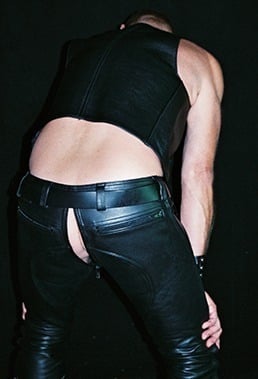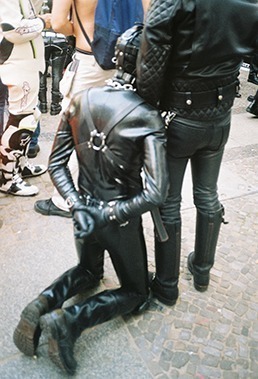Venus in Furs
Patsy l'Amour laLove
There was no such thing as a leather scene when Manfred Stavenhage discovered his leather fetish. In 1960, at the age of 16, he found himself in the shop of a Munich leather outfitter who "immediately" recognised a leather fetishist in him and put him in touch with others. Manfred bought his first leather jacket there and deposited it in the shop to hide it from his Jehovah's Witness family. With his new gay acquaintances at the time, he regularly visited the Ochsengarten pub after the strict closing time, where the landlady Auguste Wirsing let her guests in through the back door. "She really wanted to make a gay pub because her best sexual experience was with a gay man," Manfred remembers. Mrs Wirsing was persuaded to turn the Ochsengarten into a leather bar using second-hand boots as decoration - one of the most successful: later popular with Freddy Mercury and Barbara Valentin.
The legendary Munich leather bar Ochsengarten also played a role in the gay development of Olaf Hatmannsgruber and Thomas von Stein: after impressive TV experiences with the gay film classic "Cruising" (1980) and the Village People's Lederkerl, Olaf made his first contacts with the gay leather scene here in 1984. After a period of rather distanced observation, he dared to have his first "leather sex": "You try it and from then on you can start. I pluck up all my courage, stand on the three-metre board, so to speak, and now I jump!"
Thomas also remembers being fascinated by leather as a child: he was fascinated by Bavarian men in motorbike gear and pirates. So when he entered the leather scene in the 90s, he had a clear agenda: he wanted to meet such "bull-necked" men and not the "typical gay man" with a quiff and pink polo shirt, who, according to the dress code, were not allowed in the Ochsengarten fetish bar anyway.
Swan Lake with the four swans danced by gentlemen. It looked awesome.
Nevertheless, the leather scene was already very kinky back then. Manfred, who incidentally was part of the first German leather meeting, founded and ran the Munich fetish club "Löwenclub", the leather bar "Zum Lohengrin", which was named after his nickname for a long time, and was also a prop master at the Munich State Opera. According to his recollection, almost all the leathermen of the 1970s came from the theatre. The meetings of the leather clubs were often crowned by elaborate shows, of which he reports: "Swan Lake with the four swans danced by gentlemen. That looked awesome."
Nevertheless, it cannot be denied that the predominant image of masculinity in the leather scene was and still is a martial one - especially in contrast to the rather loud and tuneful gay movement. Not only sexual preferences played a role in this, but also a certain protection from direct homophobic confrontations: The "charade" of masculinity, which Olaf elaborates on as the two-pronged nature of the leather scene, served to be recognisable as a gay man in leather on the one hand - and to come across as a tough rocker or biker to most people in the heterosexual mainstream on the other. The leather clubs were also rather hidden, as a glance at the names reveals. The "Löwen" in the Munich Löwenclub refers to "leather", while the US association "Cycle MC" more or less pretended to be a motorbike club. This was to pull the wool over people's eyes, as Manfred puts it.
The USA, and San Francisco in particular, were sometimes much freer in their approach to the fetish popular among gay men. From 1987, Olaf experienced a completely different freedom there: gay leather guys in public were part of everyday life and offered a community in which he could develop - although the late 1980s heralded an extremely difficult phase in the leather scene in particular.
Over the course of the decade, from 1986 onwards, AIDS shook the leather scene, as Manfred remembers. As early as the mid-1980s, Manfred rented a cinema in Munich so that he could show an educational film on the subject free of charge with the help of film legend Manfred Salzgeber: "Some people were upset about how you could show shit like that. They simply didn't recognise the danger back then." In 1987, he lost his partner at the time to AIDS - by no means the only loss in his life. He stopped counting at 200 when he once tried to put a figure on the number of friends and acquaintances who had died. "My generation - they've almost all died out. Aids has simply destroyed a lot." Including the leather infrastructure. "Today there are maybe two leather bars left in Berlin," says Manfred, who, like Olaf and Thomas, now lives in the capital. Although he also admits that the internet has also contributed to this.
Thomas von Stein used to be a regular guest at friends' funerals. Aids dominated the gay scene in the 80s and 90s and the special "camaraderie" in the leather community countered the uncertainty and grief with a feeling of protection, Thomas remembers - even if he is critical of the term "camaraderie" today. His first relationship also broke down over the issue of safer sex. A central point of contention among gays at the time. During the AIDS era, leathermen in particular became a symbol of hard sex orgies for many - and thus personified danger. A prejudice, because Thomas remembers that the ritualised forms of play in the leather scene were actually often already safe sex. In any case, the leather scene provides an open space to explore sexuality outside of the mainstream. Thomas says that he has had a variety of sexual experiences through leather, such as learning the master role.
But what is it about the material in general? Thomas, Olaf and Manfred all talk about early memories of their fascination: acoustics, smell - and the feeling of a second skin. In addition, black leather emphasises a masculine impression. "Fancy shuffling" is not possible in a leather uniform, states Thomas. The black leather worn - with all its sensory properties - therefore lends the wearer a masculinity that, as all three also emphasise, is exaggerated to the point of hyper-masculinity.
The leather outfit is therefore a travesty of masculinity that can actually create effective illusions. It is not the individual components, but how they are worn as a whole by the leather man who becomes one through them. Among other things, the leather fetish pushes the "fetish of youth partly into the background", as Martin Dannecker writes in "Sexuality and Society". Nevertheless, a younger man who has a body in line with the prevailing ideals of beauty and is also a leather fetishist becomes "the idol of desire" in the scene. This does not mean that the gay youth cult has been completely cancelled out. In the past, Manfred even had to experience being refused entry to Berlin leather bars because of his age: "That was always my life, why should I now say I'm staying at home? They have to put up with seeing old people too. They don't have to fuck me." Nevertheless, Thomas and Olaf are convinced that you can "succeed" in the leather scene even in old age: "I think it's very pleasant to grow old as a leather man," explains Olaf. According to Thomas, the leather outfit emphasises the masculine and also pushes a tummy line into the background. The cult of beauty seems to have been somewhat cancelled out, but at the same time, he emphasises, the ideal image of the aforementioned tough masculinity prevails among many leather gays.
In the 1970s, some political pundits accused leather men of being close to fascism because of this cult of masculinity - and protested knitting in front of the darkroom in the West Berlin leather bar Knolle. In contrast, Thomas also sees this leather masculinity as a way of dealing with gay gender roles: "The insecurities and doubts about your own masculinity that you experience as a gay man - that's gone with leather." Even if the accusations of the faggots in the 70s were perhaps too simplistic, Manfred, Thomas and Olaf think a certain critical distance is definitely appropriate: leather masculinity is cool because it appears so disproportionately, but this ideal can also become a problem if it is taken seriously. "Perversity is the salt in the soup and you have to be careful not to over-salt your soup," says Manfred. However, this problem mainly concerns rigid images of masculinity, rather than perversions or the attractiveness of masculinity in leather travesties.
However, in addition to all the questions about images of masculinity and material, the aspect of community in the context of the leather scene should not be underestimated. Thomas, Olaf and Manfred all report on contacts and trips to the USA. The international and national leather scene has characterised their lives for decades. Olaf fondly remembers a huge Mister Leather election in Chicago. What impresses him, apart from the sex, are the rich characters in the scene. That's why he also organises events on his website Male.Space that don't just focus on "the sexual side": For example, his leather dinner, where he wants to publicly "provoke" with leather men in a mainstream restaurant and at the same time find greater acceptance. For Thomas, on the other hand, leather events have lost too much of their sexual drive in recent years: "It used to be about having sex and now I often get the feeling it's about who has the latest model and the smartest uniform."
Manfred also criticises this superficiality, although, like the others, he notes that gay men today are more interested in a variety of fetishes, whereas leather played a very dominant role as a gay fetish until the 1990s. This can be seen, for example, in the currently popular puppy fetish, which the three traditional leather guys tend to observe with a benevolent distance. Although Olaf organises "crossover" events, where women and people in casual outfits are sometimes allowed to attend, he also wants to see real leather outfits at a leather evening and not fashionable party harnesses.
The leather scene therefore also needs to draw boundaries as to what belongs to the leather fetish - and what does not. With a view to the many very active leather clubs from the 70s onwards or in relation to the question of too much or too little sex in the scene, the question of whether the leather scene is grouped around a sexual fetish or an identity takes centre stage here. Naturally, the answer is a tense relationship between the two. The early memories of the fascination with leather, which almost resemble those of early gay desire, are not least borne of this. And this tension between fetish and identity was the driving force behind the emergence of leather groups and their scene, which indulge in what is special about leather beyond a diffuse sexual charge. Even if the cult of masculinity is increasingly softening, as Thomas points out and welcomes, the leather scene needs the attractive stereotype of the leather man that it has built up itself and which is constantly finding new admirers. Manfred is relaxed about the changes in the scene: "Life is always changing and nobody can say that their way is the only right way."
This text originally appeared in SIEGESSÄULE 04/20, LINK: https://www.siegessaeule.de/

Photo: Spyros Rennt

Photo: Spyros Rennt

